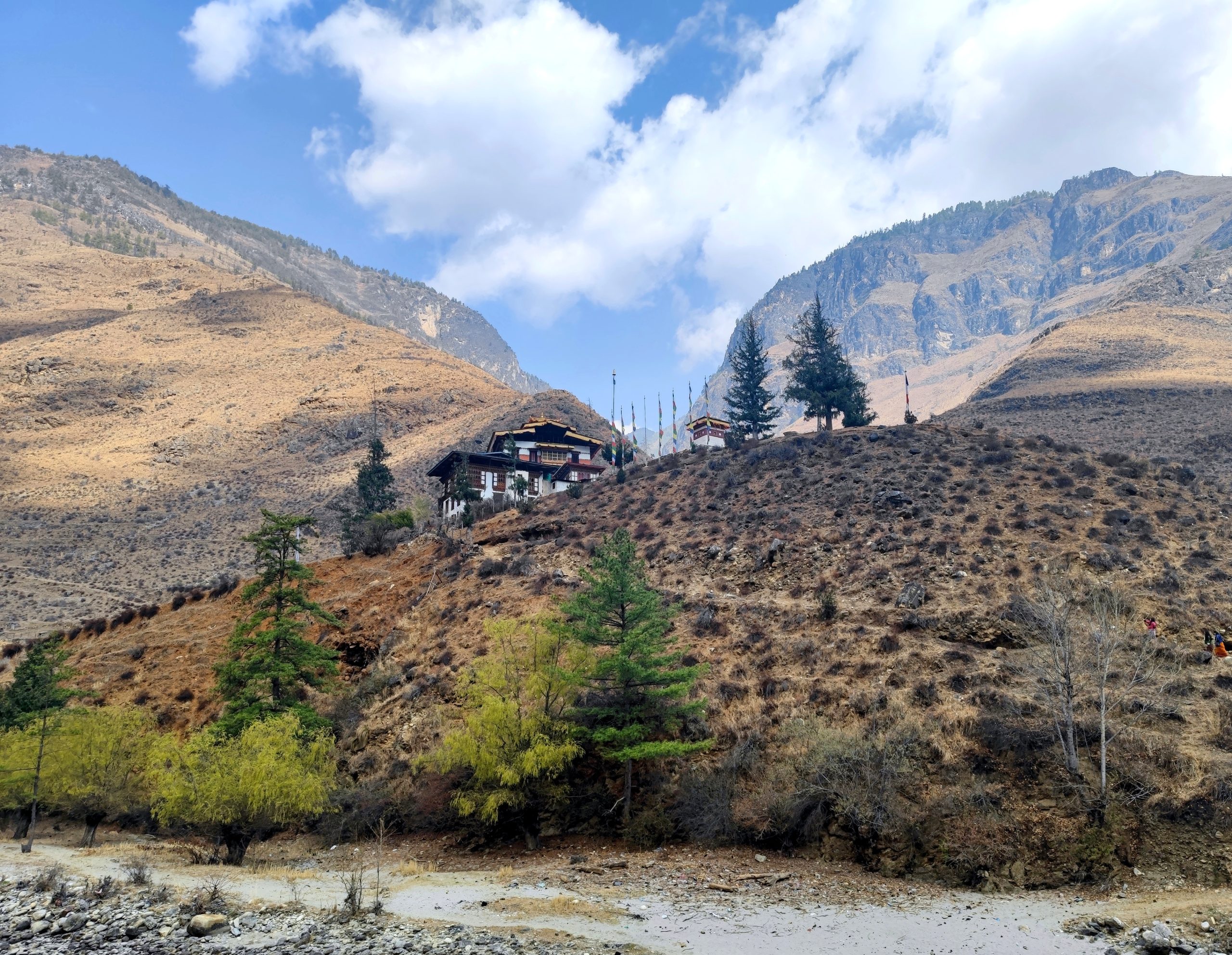
Whispers of Wisdom: A Journey’s End in Bhutan’s Majestic Mountains – Day 5.
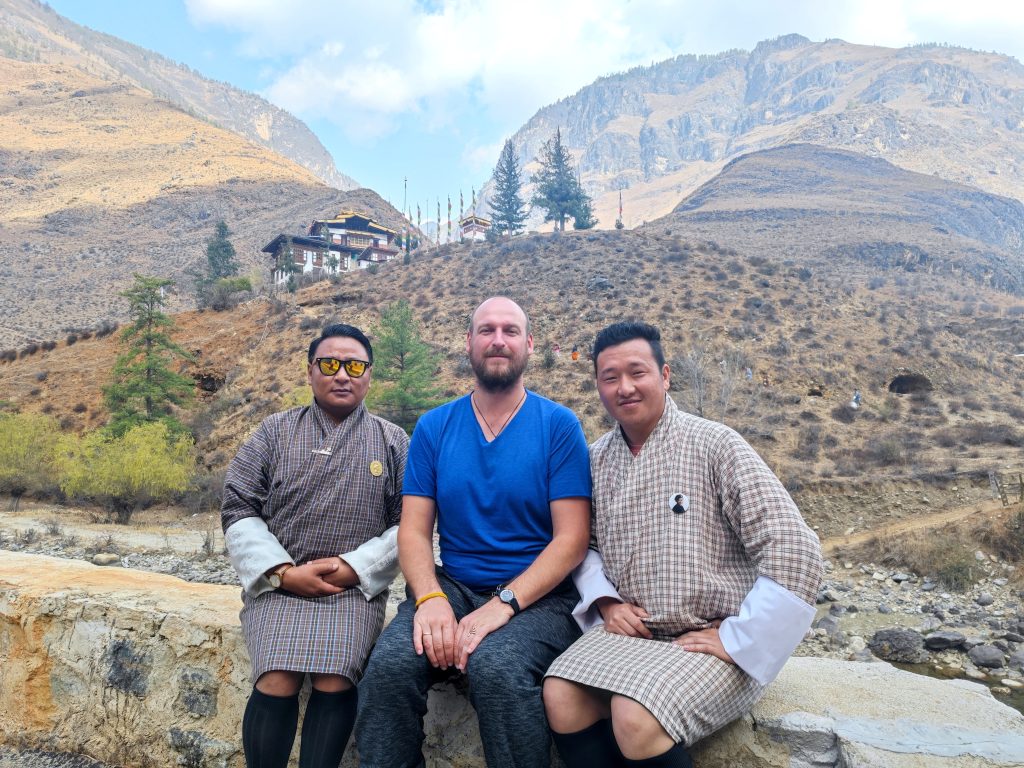
Embarking on our departure from Bhutan poses a unique challenge. Our chosen vantage point is the Paro City viewpoint, providing a spectacular panorama of the airport where planes navigate one of the world’s most perilous runways. Flight activity is limited to the early hours due to the daunting obstacles shrouded in darkness. Landing here is no simple feat; pilots navigate through a formidable mountain range with a rhythmic dance of twists and turns akin to a winding road.
Amidst the anticipation, we find ourselves fixated in the wrong direction during the descent, awaiting a departure rather than witnessing the arrival. Only one out of the three planes that touch down manages to capture our attention. Our guides, perpetually upbeat, remind us to rejoice. “We witnessed a Bhutanese plane landing—the smallest for the smallest country.” Only a dozen planes can safely land at this airport, and we’re fortunate to witness one, skillfully piloted by a woman.
Despite the challenges, our guides maintain their infectious optimism, urging us to appreciate the moment. How can we complain when surrounded by such extraordinary people? These days in Bhutan offer profound lessons on embracing the world with positivity—a reminder that reality is shaped by our perception, and nothing is inherently wrong; it’s a construct of our minds.
When we encountered a Kazakh traveler in the mountains, he shared his plans to journey from Bhutan to Bangladesh. To our surprise, we learned that flights from Bhutan to Bangladesh are a rare occurrence, with only one scheduled each month. The scarcity is attributed to the hefty daily fee of $200 imposed on Bangladeshis, too, rendering regular flights unaffordable for many. Consequently, the few available flights are gathered and operated just once a month, and today happens to be one of those rare occasions.
In contrast, flights to India offer more options. Additionally, there’s a flight to Thailand, often serving as a connecting point for locals heading to Australia. The cost of the flight to India is relatively economical, around 250 euros, while flights to Bangkok are pricier. However, opting for ground travel proves to be a more enriching experience, despite the potential challenge of navigating through winding roads. The journey itself unfolds as a genuine excursion, allowing us to absorb the diverse landscapes.
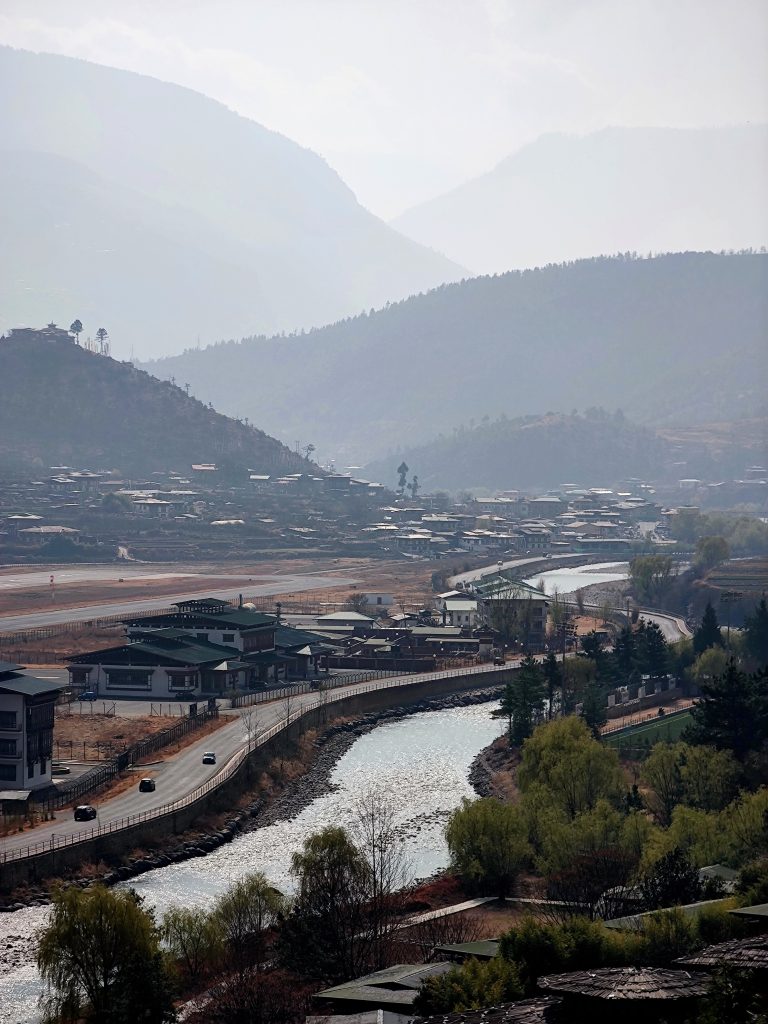
At the hill’s summit, a food bus arrives right on schedule, aware of the locals’ routine of spending quality family time during departures and arrivals. Seizing this opportunity, the bus transforms into a hub for fast food and drinks. Remarkably, it also takes on the responsibility of collecting scattered garbage, showcasing a thoughtful commitment to the environment. As the day progresses, the bus lingers, doubling as a popular date spot, ensuring it remains a fixture until the late evening hours.
The airport, a gathering point for drivers vying to pick up incoming visitors, becomes a hub for tour offers, a common occurrence for Indian travelers who sometimes come to explore Bhutan without a pre-arranged itinerary. However, venturing into monasteries is a privilege reserved for those under the care of a knowledgeable guide. Notably, a distinctive terminal with a golden roof caters to the royal family and hosts arrivals and departures of significant statesmen, both local and international.
The safety record of Bhutanese planes stands untarnished, with no reported incidents of crashes. Occasional helicopter mishaps, usually piloted by foreigners, constitute the rare exceptions. Just yesterday, an English pilot encountered misfortune as his helicopter, carrying five passengers northward, succumbed to the whims of the mountain winds. The pilot and three of the passengers survived.
A captivating story surfaces about Bhutan’s inaugural aviator. During a school visit, the king, inquiring about students’ aspirations, was astonished by a young man’s dream of becoming a pilot—a seemingly implausible ambition given the absence of airplanes and airports in the country at that time. Undeterred, the ambitious youth persisted, leaving an indelible impression on the fourth king. When Bhutan’s first airport was built, the determined dreamer received an invitation for aviation training, ultimately becoming the country’s pioneer pilot. Fondly remembered, the fourth king is hailed for his wisdom, unwavering composure, and regal demeanor—an enduring symbol of Bhutanese admiration.
As we bid farewell to Paro, one of the most captivating tourist destinations in this mountainous realm, we reflect on the rich history embedded in one of Bhutan’s most beautiful valleys. Historically, Paro served as the crossroads for two vital trade routes to Tibet, adding to its significance. Notably, the presence of numerous Indian visitors is conspicuous, prompting our guides to giggle about the ease of guiding them—content to spend much of their time by the pristine riverbanks. For these travelers from India, accustomed to rivers polluted elsewhere, the allure of clean waters here is undeniable.
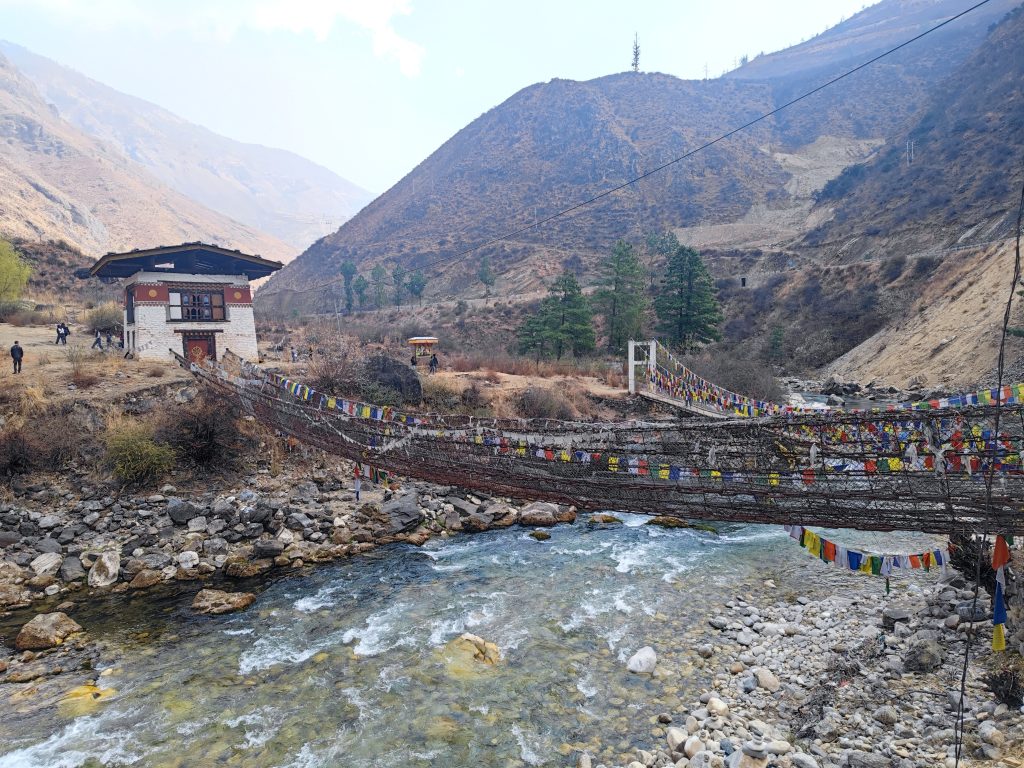
Taking stock of our journey, the extensive travel to and from Paro is evident, each leg spanning five hours. Our itinerary included the exploration of Thimphu’s main stupa and the iconic Guinness World Records Buddha, along with a visit to a distinctive post office building boasting an intriguing collection. Venturing into the mountains, we encountered 108 stupas honoring soldiers, reaching Punakha in time to partake in a traditional festival hosted by one of the most formidable monasteries. Here, we marveled at the temple of the “Mushroom lama”, wielding his magical weapon in the form of a penis to combat demons.
In Paro, we ascended a rocky pinnacle to visit the country’s most celebrated monastery, offering prayers to each deity for good fortune. Our culinary journey included savoring traditional dishes and trying out vodka mixed with egg and butter. While watching planes take off, we strolled across Bhutan’s final iron pedestrian bridge, a testament to the craftsmanship of the “Lama of Iron Bridges.” Amidst these adventures, we managed to conduct classes, a testament to the fullness of our days. With alarms sounding at four in the morning and our days concluding when others are already in bed, Bhutan has proven to be an authentic and immersive experience.
Continuing on our journey, we share with our Bhutanese friends a picture of a snow-covered landscape in Latvia, prompting them to inquire about its significance. To our surprise, they explain that in Bhutan, the absence of expected snow is considered a bad omen. In such cases, elaborate rituals are performed to avert the lurking misfortune. Adding a charming touch, Thimphu, the capital, declares an official holiday when the first snowfall occurs. Locals, waking up to a winter wonderland outside their windows, relish the prospect of a weekday snowfall, granting them the luxury of a day spent at home.
Approaching an iron bridge, now closed for crossing, we learn of the construction of a parallel bridge, preserving the old one for its historical value. Perched on the hill are temples, one notably black. Legend has it that a malevolent ghost once dwelled there, consuming anyone who passed by. Lama of Iron Bridges ingeniously turned the ghost upside down, ensuring it couldn’t spot passersby. With this intervention, the area is now devoid of such grim encounters. By the way, nearby caves served as the source of iron for the lama’s bridge-building endeavors.
Recalling our previous conversation, the Lama of Iron Bridges erected iron bridges across Bhutan, facilitating the spread of Buddhism. The tales of ghosts and lamas intertwine, painting a vivid picture of Bhutan’s cultural tapestry and the spiritual significance embedded in its landscapes
.
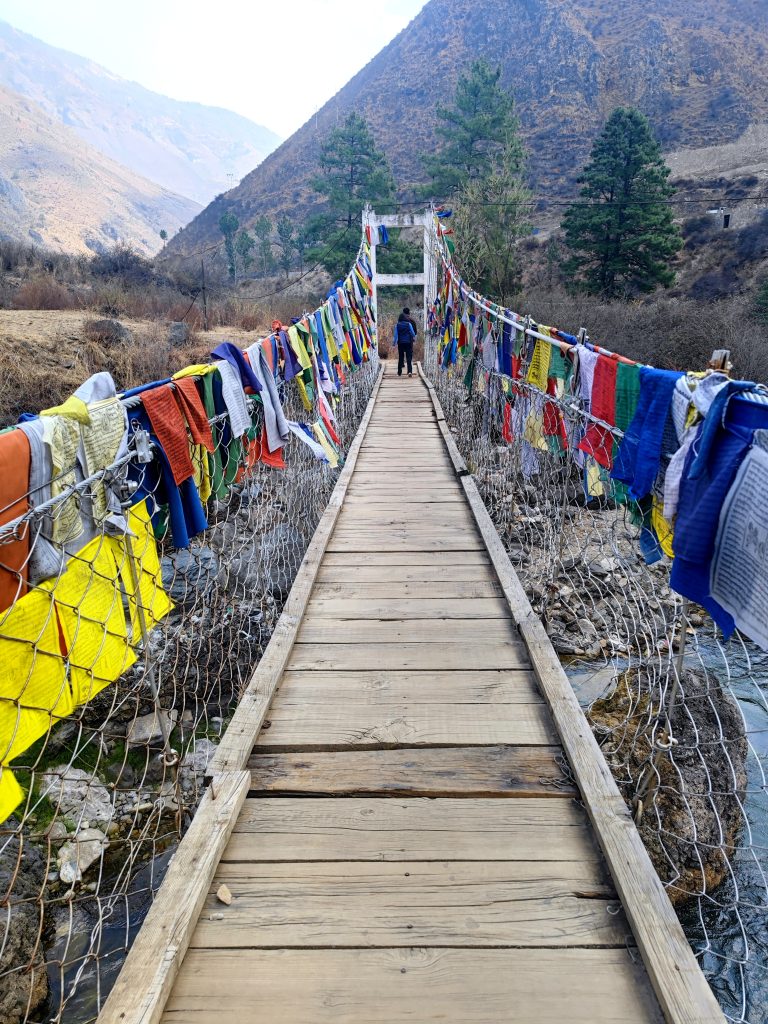
Crossing the crystal-clear river, we learn of an intriguing tale involving the “Mushroom Lama” and the absence of fish in these waters. Legend has it that two men, engaged in fishing, were challenged by the “Mushroom Lama” to a bet. The lama, confident in his skills, proposed hitting a distant target, with the condition that if he succeeded, the men would have to comply with his wishes. Unsurprisingly, the lama emerged victorious, and he commanded the men to cease their fishing activities. Initially obedient, the men resumed fishing later, provoking the lama’s ire. In response, he gathered all the fish and transported them to the northern reaches of the country, leaving the waters in the south devoid of fish.
Returning to the cave, we discover numerous small stupas crafted from flour. Following a tradition, these flour stupas are offered to the gods and carefully preserved in locations shielded from the elements, such as caves. Circumambulating the stupa three times, we acknowledge that we haven’t completed the customary 108 rounds not even once during our trip—a realization that leaves room for future journeys and discoveries in Bhutan.
Encountering another tour group, we learn of a “luxury guest,” a solo traveler who exclusively lodges in five-star hotels. Bhutan, known for its exclusivity, attracts diverse visitors, yet we opt to immerse ourselves in local experiences—patronizing local eateries and embracing the customs of the land. Despite its exclusivity, Bhutan remains a modestly affluent nation, relying significantly on tourism.
Adjacent to our location, white flags flutter on towering poles, numbering 108 as per tradition. These flags are dedicated to the departed and are renewed annually. Accompanied by recitations of the mantra “Om Mani Padme Hum,” each syllable representing the six realms, the ritual aims to guide the departed towards liberation from the cyclical nature of existence.
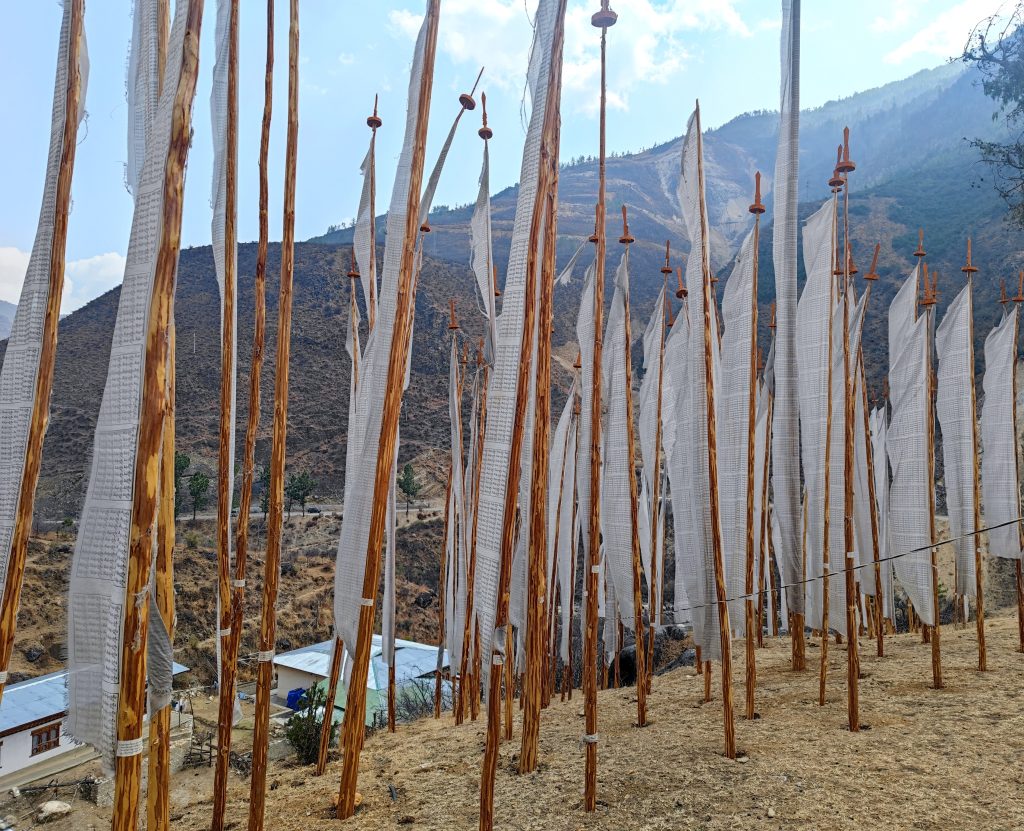
Exploring the statues of gods, we discover the intricate significance of their arrangement. Each set must feature the right combination to harness the intended luck. For example, the God of Compassion takes the central position, flanked by the God of Good and Evil on the left and the God of Wisdom on the right. Altering this order could disrupt the intended fortune.
Delving into the stupas, we find out that in each of them there are some treasures of lamas. Circling these sacred structures is believed to imbue the treasures with power, fostering a reciprocal exchange of energies.
As we observe another group of tourists, one lady expresses a hint of desperation at the prospect of climbing the mountain again. It underscores the inherent challenge of reaching the most significant temples in this mountainous country. However, these arduous journeys symbolize a profound devotion, a testament to the love for the gods demonstrated through challenging paths.
In our journey back to the border, our conversations delve into the nuances of Buddhist writing. Unlike our left-to-right writing, Buddhist scripts are written beneath the line, resulting in a straighter upper part. The uniqueness extends to names as well, where a single name can be assigned to both boys and girls. The second name often serves as a clarifier, revealing one’s true identity. The guide’s name, ‘Pema,’ translating to ‘lotus flower,’ exemplifies the significance embedded in names, akin to the Chinese tradition where each name carries a specific meaning, such as “Beautiful spring” or “Brave fighter.”
Navigating through several checkpoints, we encounter the curiosity of law enforcement officers regarding Latvia—our country that elicits questions about its location and existence. We have become the first Latvians for our guides, too. While there are no checkpoints between some of Bhutan’s 20 regions, stringent measures are in place here, closer to Indian border, to prevent the entry of illegal substances, particularly drugs, as traffickers are known to traverse challenging mountain terrains for their delivery routes. Failing to appear at a designated checkpoint after registration prompts an immediate police search in this remote and sparsely populated landscape.
Heading south, we learn from our friends that wise llamas are primarily found in the north and middle of the country, explaining the scarcity of holy places in the south. The reason for this geographical distribution remains a mystery, but the allure of seeking gurus amidst the mountains persists.
In the 17th century, the Portuguese explored the possibility of introducing Christianity to Bhutan, seeking the approval of the lamas. The locals were dissatisfied, yet the sages allowed the attempt, confident that the strength of Buddhism would prevail. Indeed, Buddhism endured, while the Portuguese moved on with their Christian endeavors.
The British presence in Bhutan involved a brief conflict, with the Bhutanese winning the initial encounter due to the unfamiliar terrain, mountains, and wildlife that caught the British off guard. However, subsequent encounters saw the British prepared, leading to Bhutan’s defeat. Over time, the two nations became friendly, with Bhutan acting as a crucial intermediary for trade between British-ruled India and Tibet. Interestingly, it was the British who introduced the first potato seed to Bhutan, a culinary addition that, while enjoyed by locals, still does not surpass the prominence of rice in their diet.
The dietary habits in Bhutan reflect a unique blend of tradition and modernity. While Bhutanese do consume meat, it is predominantly imported from India since this country prohibits killing animals. This practice occasionally results in surprising variations, where donkey might substitute for pig, and dove for chicken. Indian cuisine, rich in spices, further adds an element of mystery to the types of meat used. Attempts to make Bhutan a vegetarian country have faced challenges, particularly due to the lifestyle choices of the urban elite, who don’t adhere strictly to such rules. Although animal sacrifices are no longer part of religious rituals, the influence of modernization makes it challenging to adhere to traditional Buddhist principles. While global fast-food giants like McDonald’s and KFC are absent, local alternatives, such as CFC, offer familiar options. Our guides wonder how much time would it take for Bhutan to open its first rollercoaster park. Well, modernization is still ahead.
As we traverse the winding roads with our friends, we observe the dynamics of their partnership in guiding tours. Our “pilot” with 12 years of experience in the field, complements the guide who recently embarked on this profession. The interesting and engaging tour experience reflects their combined efforts, making them a commendable team. Choosing a guide involved an extensive process, including evaluations of prices and establishing a personal connection. And here we are – with the best possible team in Bhutan!
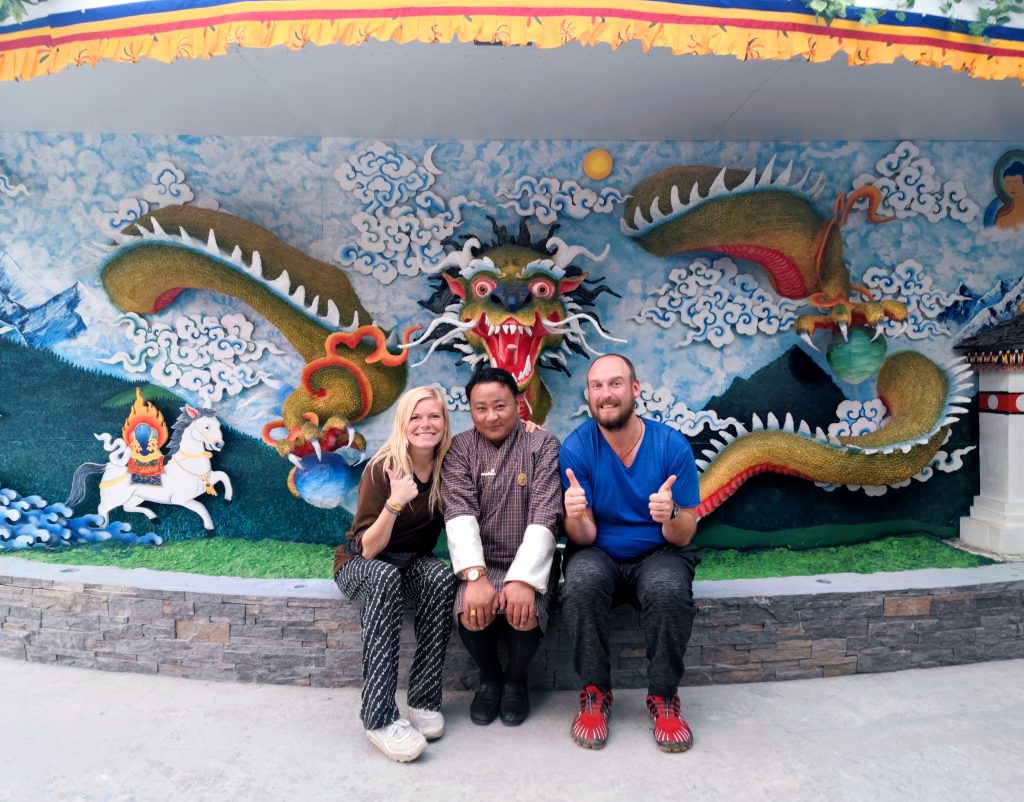
In terms of international relations, Bhutan has a difficult time with China. Talks between the heads of state addressed concerns about the gradual occupation of territory. However, after leaving China, the Bhutanese experienced the same negative effects that were not supposed to continue anymore. The relationship between Bhutan and China is not substantial, with the Dalai Lama expressing the belief that Tibet will only achieve freedom when the Chinese ruler is changed… An event unlikely to be witnessed soon.
The tales of the lamas, particularly the amusing “Mushroom Lama,” captivate our conversations. One intriguing aspect discussed is the national animal of Bhutan—the takin, a creature with the head of a goat and the body of a cow. Legend has it that during a traditional holiday, the “Mushroom Lama” indulged in festivities, including meat consumption, prompting locals to request a miracle. In response, the lama took a goat and a cow, and before everyone’s eyes, a hybrid of the two animals, the takin, emerged. Instructing them to graze in the high mountains, these unique creatures can only be found in the elevated regions above 3,800 meters.
The humor in Bhutanese tales often centers around the mischievous “Mushroom Lama,” who played pranks, unlike other lamas. Notably, he had a brother who adhered to the traditional lama lifestyle, refraining from marriage. However, their mother insisted that the “Mushroom Lama” get a wife to help with household chores. In jest, he brought an old woman, declaring her as his wife to the displeasure of his mother. The lama maintained the fiction, claiming his mother could replace the old woman. The story takes a humorous turn when, during the night, the lama insists on sleeping with his mother, causing embarrassment. While there are various versions of the story regarding the events of that night, it’s clear that the next day, the lama announced to the entire village that he had slept with his mother. The shock and shame experienced by his mother, according to the tale, contributed to her eventual ascent to Heaven after death. The lama, seemingly aware of his mother’s fate, orchestrated the situation to ensure her heavenly journey—a testament to the unconventional yet moral tales in Bhutanese folklore.
Descending from the mountains, we choose the most crowded restaurant among the mountain eateries, guided by the clever strategy that guides receive free coffee and snacks. This choice proves advantageous, as tourists typically spend more than the cost of the guide’s consumption. Delving into Bhutanese culinary traditions, we try Suja, a traditional tea with butter and salt, accompanied by cheese momos and a gravy boasting 43 ingredients—an experience that tantalizes not only the eyes but also the stomach.
As we navigate the roads, our friends advise caution, particularly when encountering the three L’s driving: lady, learner, and lama. Foggy areas pose particular risks, with tales suggesting that certain villages are perpetually shrouded in fog due to a curse from a lama who was not properly welcomed. Although not an official story like those of the “Mushroom Lama,” it adds a mysterious layer to the local folklore.
The descent is not without its challenges, as an accident is witnessed—an unfortunate fall off a cliff. Expressing sympathy for the unfortunate event, we prioritize safety as we continue our journey downhill. Upon leaving Bhutan, the transition is astonishing – a departure into what feels like an entirely different world. As we leave behind the captivating mountains of Bhutan, it seems as though we have stepped back into a familiar, albeit slightly transformed, version of India. The surroundings become a little louder, and the presence of stray animals is a bit more pronounced.
Led to a local tavern, not one frequented by foreigners, we are greeted by a weathered exterior with tin plates askew and a crooked sign that reads “Bar.” However, stepping inside reveals a hidden gem. The atmosphere is electric, illuminated by a kaleidoscope of colorful lights. Locals, including the younger crowd, occupy the space, indulging in beer and tobacco pipes – a stark contrast to the no-smoking culture we had experienced in Bhutan.
The notion of smoking in public, which would have been unthinkable in Bhutan with its secret agencies, adds an element of rebellion to our evening. Our local friends continue to treat us like royalty, ensuring the bartender faces their ire if our appetizers are delayed even for a moment. “You won’t be forgotten that easily – you’re the first foreigners to grace this place!”
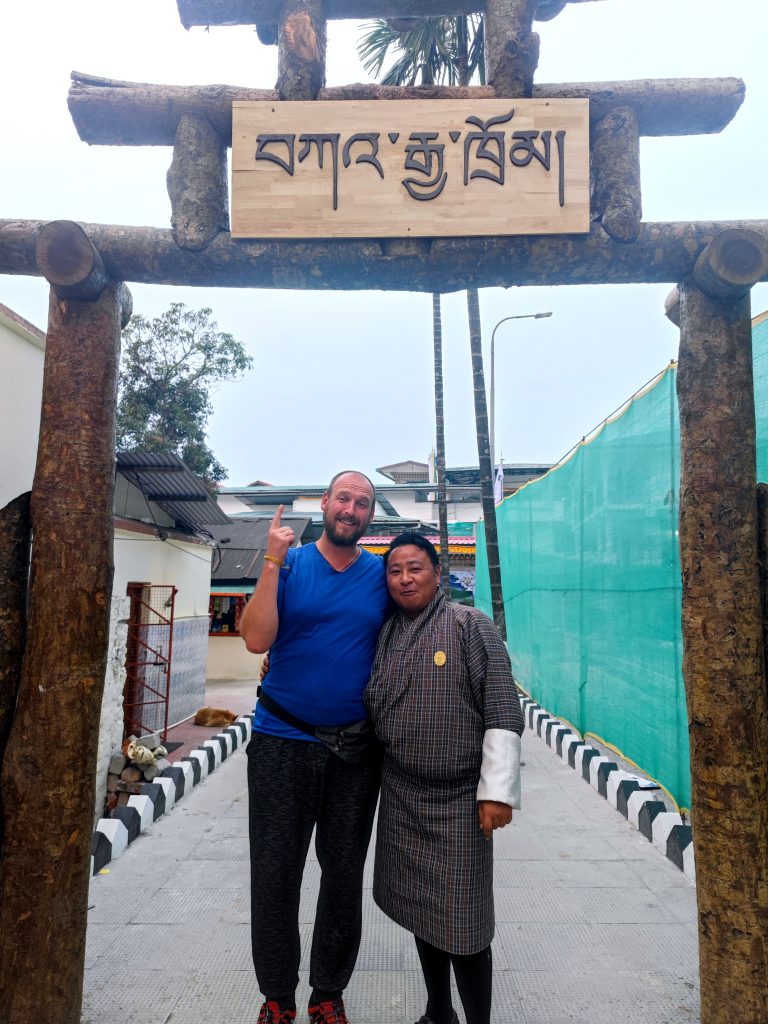
Our tour had been nothing short of fantastic, and our guides, unparalleled in their hospitality, made every moment memorable.
The festivities continue, and we dance and celebrate until the clock strikes eight, signaling our return to India. While the border on the Bhutanese side remains open until midnight, the Indian side operates on its schedule, allowing entry and exit as they please, starting as early as eight in the evening. Our Bhutanese friends accompany us, and it’s evident that the transition to India poses a challenge for everyone, given the apparent chaos. Their traditional attire stands out amidst the eclectic mix, and the presence of us – two foreigners – adds to the unique spectacle.
As our enchanting five-day journey through Bhutan comes to a close, my husband and I find ourselves deeply grateful for the myriad experiences this mountainous haven bestowed upon us. From exploring Bhutan’s iconic landmarks to delving into the profound teachings of Buddhism, each moment has been a treasure trove of cultural richness. The vibrant tapestry of this fantastic country has left an indelible mark on our hearts, resonating with the warmth of its people and the serenity of its landscapes. As we bid farewell to the Land of the Thunder Dragon, we carry with us not just memories of places but a profound understanding of Bhutan’s soul, a true mountain pearl nestled in the heart of the Himalayas.
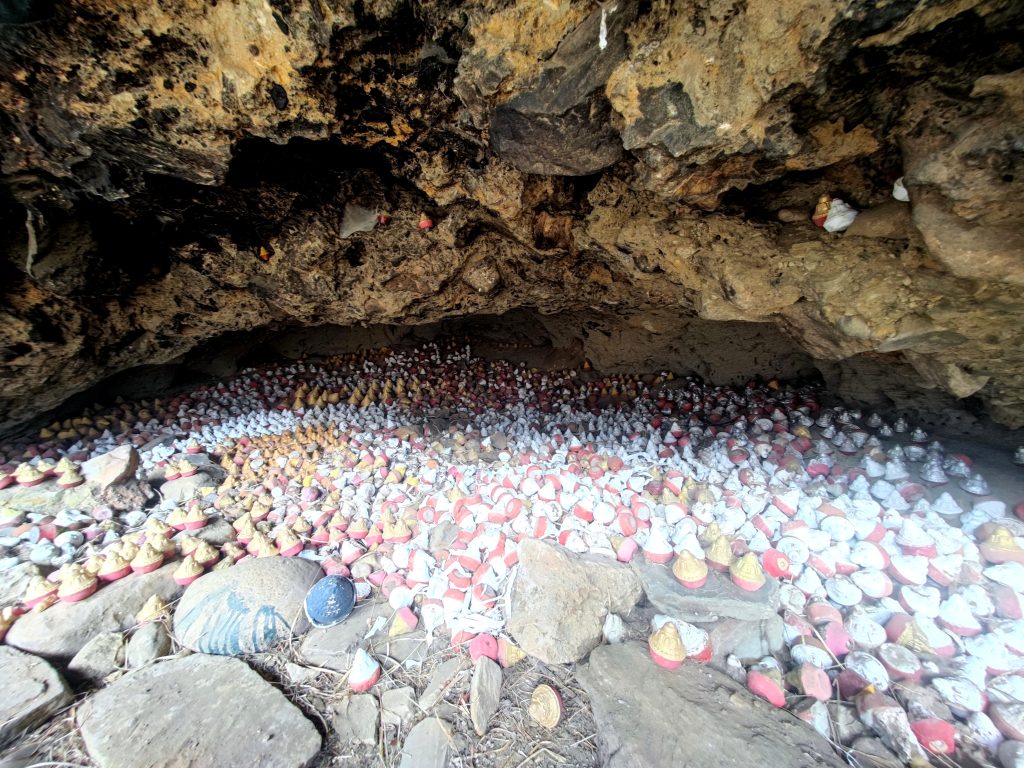
Dear reader, we extend our heartfelt gratitude for joining us on this Bhutanese odyssey. Your presence has added depth and meaning to our journey through the enchanting landscapes and cultural treasures of this remarkable country. As we bid farewell to the tales and adventures woven into the fabric of Bhutan, we appreciate your company in making this narrative truly special. Until we embark on the next chapter together, thank you for being an integral part of our Bhutan story.